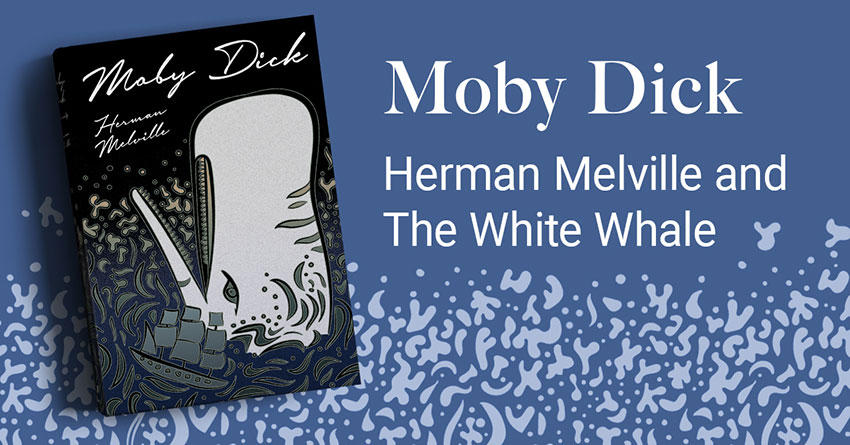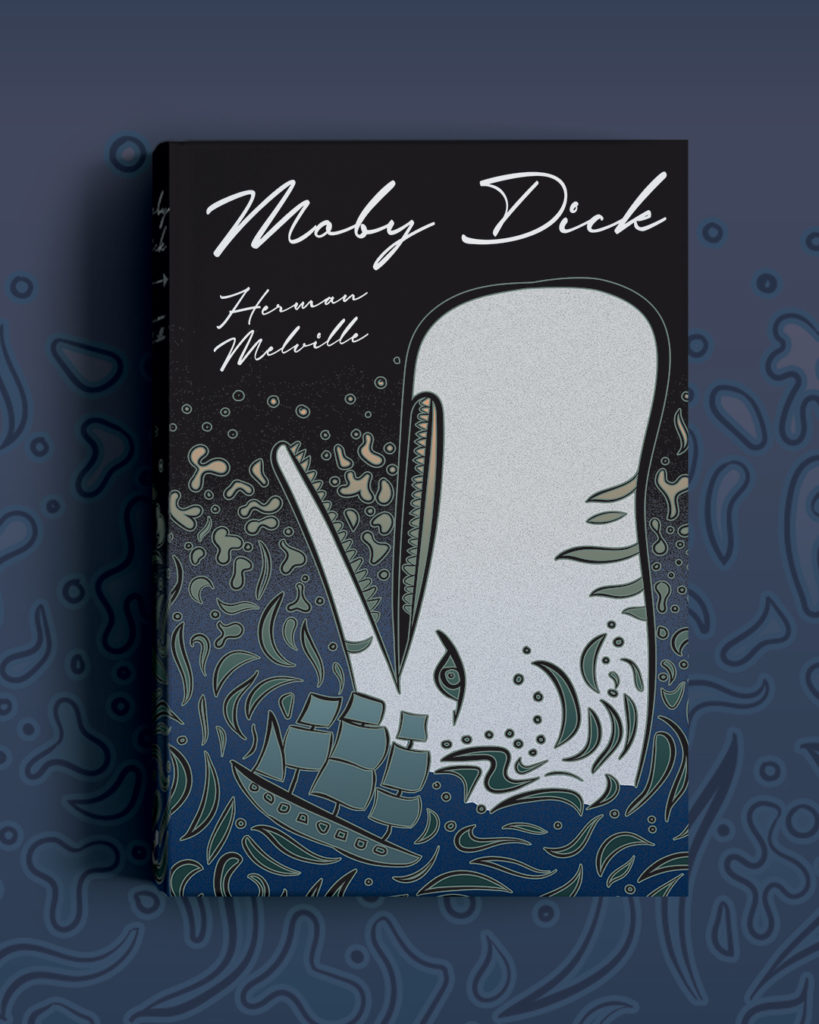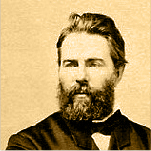A New Beautiful Edition of Moby-Dick
In celebration of American author Herman Melville’s birthday, born August 1st 1819, we are proud to present a new beautiful edition of his world-famous work – Moby-Dick.
Moby-Dick; or The Whale, was first published in London in 1851. Upon publication, the novel received terrible reviews and was deemed a commercial failure. It was only years after the author’s death when critics rediscovered it, that it gained a reputation as one of the Great American Novels. It is now widely regarded as Melville’s magnum opus.
‘One of the strangest and most wonderful books in the world’ – D.H. Lawrence
The Story of The White Whale
The book’s immortal opening line, ‘Call me Ishmael’, begins the narrative of a young sailor who recalls a voyage to sea on a whaling vessel. The sailor, Ishmael, signs up for the final voyage of the Pequod – a whaling ship bound for the Indian ocean. Onboard, he joins a group of whalers to hunt and kill sperm whales to harvest their oil.
Chock full of colourful characters that all bear biblical renaissance, Ishmael is thrown into an obsessive quest to capture the infamous white whale – Moby Dick.
Spurred on by the estranged captain of the ship, Ahab, who wants revenge for the loss of his leg to the whale on a previous expedition, Ishmael and his onboard companions embark on a journey to hunt and kill Moby Dick, no matter the cost.
“There is, one knows not what sweet mystery about this sea, whose gently awful stirrings seem to speak of some hidden soul beneath.”
Symbolism and Themes in Moby-Dick
Along with its iconic plotline, Moby-Dick is famous for its ambiguous symbolism.
While he was writing Moby-Dick, Melville’s close friend, Nathaniel Hawthorne, suggested that he re-write the book using more metaphors. He suggested that Melville use ‘whaling as a form of psychological insight into the human condition’ which consequently changed the book from a simple narrative to what we know today.
This focus on the human condition is demonstrated through the core theme of incomprehensible obsession, and the eventual existential unhinging of Abram’s character.
Another symbolic element comes in the form of the colour white: the White Whale, Ishmael’s obsession with the colour white, and the representation it has in life and death at the same moment.
“Ishmael muses on the many, often conflicting resonances of whiteness: its sleek beauty, its existential terror, its fullness, its funereal emptiness.”
– Gabrielle Bellot, The Literal (and Figurative) Whiteness of Moby Dick
Not to mention the considerable theme of religion from the vast array of characters with biblical names. For example, the protagonist Ishmael is named after the illegitimate son of Abraham from the Old Testament. In the bible, Ishmael is cast aside in favour of the legitimate son, Isaac, and banished to the wilderness – much like Melville’s Ishmael, who is also a wanderer and an outcast. Another character, Captain Ahab, shares the name with the biblical King Ahab – once a cruel ruler of Israel, and much like the king, Captain Ahab’s ‘misguided passion’ ends up costing him considerably.
Melville successfully filled his novel with so much symbolism that it has been countlessly interpreted over the years. Thanks to its vast plot and layers, it remains relevant even now, understood differently by each new generation that picks it up.
Herman Melville - His Life and Legacy of Moby-Dick
Born in New York City in 1819, Herman Melville came from wealthy beginnings. His father went bankrupt and then died when Melville was 12 years old, meaning he began working at a young age, holding a variety of jobs throughout his early years.
At the age of twenty, he was shipped out as a cabin boy on a whaling ship named Acushnet. His experience onboard this vessel would later go on to be translated into his now world-famous novel Moby-Dick.
Following his whaling trip, Melville had a short career in the Navy. He wrote his first two novels; Typee and Omoo, inspired by his travels. Although of fictional narrative, Typee was mostly autobiographical, influenced by his personal experiences in the tropics among the Typee cannibals of Marquesas Islands.
After the success of his first two novels, Melville continued to create narrative books based on his personal experiences. After moving to Massachusetts, he became very close to author Nathaniel Hawthorn, and the pair had a significant influence on each other’s work. So much so that Melville dedicated his epic novel to Hawthorne:
In token of my admiration for his genius.
– Herman Melville, Moby-Dick
Drawing from his own experiences as a young man, and also by the story of the Essex – a whaling ship that was attacked by a sperm whale in 1820, sinking the ship and killing the crew – Melville published Moby-Dick in 1851.
It was deemed a complete commercial flop upon release selling around 3700 copies in his lifetime – only a third of what his first novel Typee had sold.
Nearly having bankrupted himself to publish Moby-Dick, Herman Melville turned his hand to writing short stories. Typically printed in publications, one of his most famous stories was ‘Bartleby the Scrivener’ published in Putnam’s Monthly Magazine in 1853.
He went on to write lots more stories and novels, and in the later years of his life, turned his hand to poetry although publication prospects were not favourable. His most significant work of this period was his posthumous novel, Billy Budd. However, this remained unpublished until three years after his death.
Herman Melville died on the 28th September, 1891.
“His life was neither happy nor, by material standards, successful. By the end of the 1840s he was among the most celebrated of American writers, yet his death evoked but a single obituary notice”
Thirty years after his death in 1921, American academics rediscovered his work. Understanding why it had been so poorly received in its day, they hailed Melville for his experimental writing, universal themes and symbolism, and being nearly a century ahead of his time.
Moby-Dick is now regarded as one of the great American novels, having been adapted and represented countless times in 20th and 21st-century culture through film, theatre, music and more. With many readers preceding it re-writing and interpreting Melville’s novel, Moby-Dick remains ‘a true cultural icon‘.
“The novel’s ability to produce numerous interpretations is, perhaps, the main reason it is considered one of the greatest American novels.”




